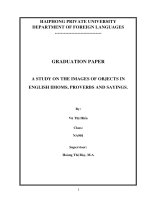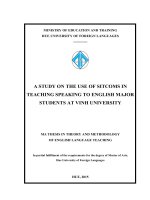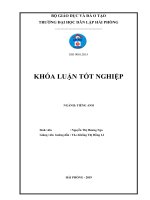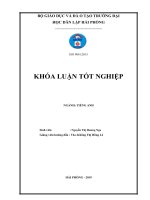A study on illocutionary acts of expressives in modern american short stories
Bạn đang xem bản rút gọn của tài liệu. Xem và tải ngay bản đầy đủ của tài liệu tại đây (868.79 KB, 73 trang )
MINISTRY OF EDUCATION AND TRAINING
QUY NHON UNIVERSITY
HỒ THỊ MINH TÂM
A STUDY ON ILLOCUTIONARY ACTS OF
EXPRESSIVES IN MODERN AMERICAN SHORT
STORIES
FIELD: English Linguistics
CODE: 8.22.02.01
Supervisor: HÀ THANH HẢI, PhD
BỘ GIÁO DỤC VÀ ĐÀO TẠO
TRƯỜNG ĐẠI HỌC QUY NHƠN
HỒ THỊ MINH TÂM
NGHIÊN CỨU CÁC PHƯƠNG THỨC DIỄN ĐẠT
THUỘC HÀNH VI TẠI LỜI TRONG TRUYỆN NGẮN
HIỆN ĐẠI HOA KỲ
Ngành: Ngôn ngữ Anh
Mã số: 8220201
Người hướng dẫn: TS. HÀ THANH HẢI
i
STATEMENT OF AUTHORSHIP
I consequently certify that this master thesis has been written by myself
and describes my own work, unless otherwise stated in the text. All references
or sources of information have been clearly acknowledged and are included in
the References. Furthermore, identical extracts have been quoted extensively.
This thesis has not been approved in any previous application for another
degree or diploma.
Binh Dinh, 2023
Ho Thi Minh Tam
ii
ACKNOWLEDGEMENTS
First of all, I would like to express my deep appreciation to my supervisor,
Doctor Hà Thanh Hải, who has given me much great advice and encouragement
during the time I managed to complete this thesis. I am also indebted to her for
spending his time to read my manuscripts and make the necessary changes.
I would like to extend my gratitude to the lectures of this course for their
valuable lectures, materials, and experiences which have contributed to the
foundation of my thesis.
I am very much thankful to my friends for encouraging me and providing
me with needed materials.
My warmest thanks are given to my beloved family who always takes care
of me and helps me overcome a lot of stress throughout the course as well as
the study of this thesis.
Binh Dinh, 2023
Ho Thi Minh Tam
iii
ABSTRACT
Expressives as illocutionary acts emerge as one of the most strictly typical
pragmatic characteristics and indicate the speaker’s feelings, attitude, and
psychological state, particularly in modern short stories. Based on the
illocutionary acts, 10 modern short stories from well-known American authors
(Kate Doyle, Caitlin Horrocks, Mia Alvar, Alexandra Kleeman, John Wiswell,
etc.) are collected to demonstrate how expressives as illocutionary acts are used
in modern American short stories. The purpose of this study is to analyze and
classify the syntactic and functional aspects of expressives as an illocutionary
act that can be found in 145 turns containing expressives in modern American
short stories. The theory from Quirk and Greenbaum's (1973) is used to analyze
the syntactic features of expressives as an illocutionary act. There are four
syntactic features of expressives as an illocutionary act, including declaratives,
interrogatives, imperatives, and exclamatives. Then, Searle's analytical
framework (1979) is used to analyze the functions of expressives as an
illocutionary act. There are six functions of expressive acts based on Searle's
(1979) theory. Those are thanking, apologizing, congratulating, greetings,
wishing, and attitudes. This thesis also uses both quantitative and qualitative
methods. All the things the characters say are looked at using descriptive
methods, discussion, and comments to find out what we can learn about the
syntactic and functional tasks that need to be done. Despite the limitations of a
small study and the lack of time, the researcher hopes that the thesis will
contribute to increasing awareness of pragmatics and clarifying illocutionary
act theory with specific analysis and interpretation of expressives as
illocutionary acts in modern American short stories.
Keywords: Pragmatics, illocutionary acts, expressives, modern American
iv
short stories, syntactics features, functional features.
v
TABLE OF CONTENTS
STATEMENT OF AUTHORSHIP ................................................................... i
ACKNOWLEDGEMENTS .............................................................................. ii
ABSTRACT .....................................................................................................iii
TABLE OF CONTENTS .................................................................................. v
LIST OF TABLE ...........................................................................................viii
LIST OF FIGURES.......................................................................................... ix
CHAPTER 1: INTRODUCTION.................................................................. 1
1.1. Rationale................................................................................................. 1
1.2. Aims and objectives ............................................................................... 3
1.2.1. Aims ................................................................................................ 3
1.2.2. Objectives ........................................................................................ 3
1.3. Research questions ................................................................................. 4
1.4. Scope of the study .................................................................................. 4
1.5. Significance of the study ....................................................................... 4
1.6. Organization of the study ....................................................................... 5
1.7. Summary................................................................................................. 5
CHAPTER 2: LITERATURE REVIEW...................................................... 6
2.1. Previous studies ...................................................................................... 6
2.2. Theoretical background .......................................................................... 9
2.2.1. Pragmatics ....................................................................................... 9
2.2.2. Speech Acts theory ........................................................................ 10
2.3. Illocutionary Acts ................................................................................. 14
2.3.1. The definition of Illocutionary Acts ........................................... 14
2.3.2. Classification of Illocutionary Acts .............................................. 16
2.4. The definition of Expressives .............................................................. 19
2.4.1. Syntactic features of English sentences ........................................ 21
2.4.2. Functional features of Expressives................................................ 24
vi
2.5. Context ................................................................................................. 26
2.6. Summary .............................................................................................. 28
CHAPTER 3: METHODOLOGY............................................................... 29
3.1. Research Designs ................................................................................. 29
3.2. Data Collection..................................................................................... 29
3.3. Data Analysis ....................................................................................... 30
3.4. Research Procedures ............................................................................ 31
3.5. Validity and Reliability ........................................................................ 31
3.6. Summary .............................................................................................. 32
CHAPTER 4: FINDINGS AND DISCUSSION ......................................... 33
4.1. Findings ................................................................................................ 33
4.1.1. The syntactic features of expressives as an illocutionary act in
modern American short stories. .............................................................. 33
4.1.2. The functional features of expressives as an illocutionary act in
modern American short stories. .............................................................. 40
4.2. Discussion ............................................................................................ 48
4.2.1. The syntactic features of expressives as an illocutionary act
performed by the charaters in the ten of modern American short
stories. 49
4.2.2. The functional features of expressives as an illocutionary act
performed by the charaters in the ten of modern American short
stories. 49
CHAPTER 5: CONCLUSION..................................................................... 51
5.1. Conclusion............................................................................................ 51
5.2. Implications .......................................................................................... 52
5.3. Limitations of the study ....................................................................... 53
5.4. Suggestion for further research ............................................................ 54
REFERENCES .............................................................................................. 55
vii
APPENDIX
viii
LIST OF TABLE
Table 4.1.1. The Syntactic Features of Expressives as an Illocutionary Act in
Modern American Short Stories. ................................................ 34
Table 4.1.2. The Functional Features of Expressives as an Illocutionary Act in
modern American short stories . ................................................. 41
ix
LIST OF FIGURES
Figure 4.1.1. Number of Syntactic Features of Expressives as an Illocutionary
Act in Modern American Short Stories. ..................................... 34
Figure 4.1.2. Number of Functional Features of Expressives as an Illocutionary
Act ............................................................................................... 41
1
CHAPTER 1: INTRODUCTION
The present chapter describes the major components of the thesis and
provides the rationale for the study. At the beginning, the main reasons for
conducting the study is presented. The aims of the thesis then is stated, and
clarified by the research questions. The scope and significance of the current
study are also discussed in the chapter. It ends with a description of the
organization of the thesis.
1.1. Rationale
It is widely accepted that communication is an essential need in our lives,
and language is one of the most effective and successful means of
communication. As a result, when we communicate, language plays an
important role. It cannot be denied that when speaking, the speaker must
consider not only the content of the speech but also how to express it so that
the listener can understand it easily. Furthermore, speakers frequently use
speculative statements, forcing listeners to deduce both the speaker's literal and
implicit meaning. Because of the reasons above, mastering the relationship
between the external form and the underlying purpose of an utterance are
regarded as the golden key to successful communication.
According to Griffiths (2006), the act of speaking is the fundamental unit
of language interactions such as warnings, greetings, applications,
communicating information, confirming appointments, and other expressions.
Every expression that people use in everyday conversation is an example of a
illocutionary acts, but they are unaware of it. Illocutionary acts, obviously,
cover a wide range of languages; all sentences that people say are illocutionary
acts, as is the word "hello", which is one example of a speech act to say hello
and ask. As a result, the act of speaking is performed every day, at any time,
and anywhere in the world.
Illocutionary acts are utterances made by two or more people acting as
2
speakers and listeners (Yule, 1996). Therefore, illocutionary acts have always
occupied a prominent and leading position in the study of pragmatics in
particular and language use in general. That is, speech behavior is regarded as
one of the most typical pragmatic features, which is crucial in the
communication process in everyday contexts as well as in the process of
language teaching and learning.
Indeed, among the five types of illocutionary acts, it is expressives that
emerge as one of the most strikingly typical pragmatics characteristics,
particularly in modern short stories. However, despite the fact that expressives
have occuppied an importantly irreplaceable position in terms of speech act
studies, there has been a lack of research putting much emphasis on such
expressive-related issues under the umbrella of pragmatics perspective.
In fact, there are numerous sources of valuable reference material
available, including both the media and published literature. This provides
numerous advantages to teachers and students while getting them engaged in
daily English and Vietnamese conversation. Reading allows people to learn
more and widen their knowledge. Furthermore, people can improve their
language skills in a variety of settings by reading modern American short
stories. Researchers studying linguistic behavior can benefit from reading
modern American short stories. Famous works of this genre have always
piqued the interest of readers not only in Vietnam, but almost everywhere in
the world. Through modern American short stories, we have a deeper insight
into the culture of communication by using illocutionary acts. It is extremely
beneficial for improving people's pragmatic abilities and assisting us in
becoming more successful communicators in English.
In addition, the topic of discussion is chosen due to the appeal of a
character in modern American short stories to be evaluated. Researchers can
reach a broader audience through reference and conversation. Researchers can
3
interpret or describe how illocutionary acts occur in a new character.
Expressives as illocutionary acts analysis research can also be done in the form
of a literary work in the form of a text, where the study of speech actions is not
limited to the original person who talks, or in the form of video. This study
employs novel objects because short tales are imaginary prose narratives that
often depict character and action in written form. Linguistically, many aspects
in modern American short tales must be studied in terms of pragmatic
comprehension, such as implicature, presupposition, and speech acts.
Furthermore, modern American short stories have distinct literary styles that
allow readers to readily understand them.
Finally, as far as I know, there are also a number of studies on expressing
illocutionary acts used in modern American short stories, so this thesis hopes to
provide more complete and richer material of illocutionary acts for everyday
communication. The research will also help people comprehend illocutionary acts
of expressives and be proficient in applying them.
All these factors have created the tremendous motivation for me to conduct this
research.
1.2. Aims and objectives
1.2.1. Aims
The aim of my research is to analyze expressives as an illocutionary act in
modern American short stories. Through the analysis of turns containing
expressives as illocutionary acts in these modern American short stories, we will
find out syntactic and functional features of expressives used from their detailed
characteristics employed to realize them.
1.2.2. Objectives
In order to achieve the aim of the research, there are two objectives as follows:
- To find out the syntactic features of expressives as an illocutionary act
in modern American short stories.
4
- To find out the functional features of expressives as an illocutionary act
in modern American short stories.
1.3. Research questions
The thesis is made to answer two following questions:
1. What are the syntactic features of expressives as an illocutionary act in
modern American short stories?
2. What are the functional features of expressives as an illocutionary act in
modern American short stories?
1.4. Scope of the study
By virtue of limited time and research conditions, it is obviously difficult to
conduct a large-scale investigation of illocutionary acts in all modern American
short stories. Instead, this thesis will focus mainly on the syntactic and the
functions of expressives as illocutionary acts collected from about 10 modern
American short stories in the 21st century chosen. The short stories are chosen
based on their potential to win literary awards and each short story ranges in
length from 2000 to 5000 words.
1.5. Significance of the study
The study is expected to contribute to the field of pragmatic analysis
studies, particularly illocutionary acts research, which still receives not much
attention from scholars in the field. In terms of theory, this research helps to
make a contribution to the study, performance and interpretation of
illocutionary acts as well as help to clarify the illocutionary acts theory thanks
to detailed analysis and interpretation of the illocutionary acts utilized in
modern American short stories. In terms of practice, the manipulation of
indirect types in modern American short stories into real-life contexts to
reinforce the effectiveness and efficiency of communication and language
teaching-learning process is worth to consider.
5
1.6. Organization of the study
This study consists of five chapters, each of which takes responsibility for a
particular function, The first chapter is Introduction, which reveals an overview of
the study including rationale, research aims and objectives, research questions, the
scope of the study, the significance of the study, organization of the study. The
second chapter is Literature Review and Theoretical Background, which presents
a review of previous relevant studies and all the terms as well as the key theoretical
concepts that the study is based on so that the next part of the study can be easily
friendly read. The third chapter is Research Methodology, which describes the
methods used in the study. Additionally, the procedures applied to collect and
analyze the data for the study and clarification of validity and reliability are also
mentioned. The next chapter is Finding and Discussion, which depicts the result
of the study from the collected data based on the two questions mentioned above
and a detailed discussion with illustration, interpretation, and comments about
expressives of illocutionary acts in modern American short stories in both
structures and functions, which are all based on the Theoretical background and
analytical frameworks presented in the chapter Two and chapter Three. The final
chapter is Conclusion, which summarizes the results and findings of the research
which concern the expressives in syntactics and functions of illocutonary acts in
modern American short stories. Finally, some implications, the limitations of the
study and suggestions are given for further research related to the topic.
1.7. Summary
An overview of the research, including the justification, the goals and
objectives, the research questions, and the study’s cope, is intended to be provided
in the first chapter. This section also presents the framework of the thesis and the
significance of the investigation. This can help readers understand the main ideas
of the thesis and the historical background of the research.
6
CHAPTER 2: LITERATURE REVIEW
The chapter focuses on a review of previous, relevant studies, theoretical
background of illocutionary acts which consist of the definition, levels, and
classification. Next, the syntactic and functional features of expressives as
illocutionary acts are indicated.
2.1. Previous studies
The theory of speech acts in pragmatics is a topic that many researchers
are interested in, yet perspectives on the subject are still divided. As a result, it
may be stated that the difficulties of pragmatics in general and illocutionary
acts in particular remain unexplored territory.
There are many studies on pragmatics, including illocutionary acts. Some
research works are mentioned by some famous linguists in the world such as
Austin, Searle, Yule and so on. First, the theory of speech acts is associated
with John Austin, a British language philosopher whose book "How to Do
Things with Word," published posthumously in 1962, marked the beginning of
a new approach to the study of language. In this book, Austin attacks the view
that the function of language is to state facts. He gives some new perspectives
on semantic analysis and points out three types of speech acts expressed in each
utterance: locutionary acts, illocutionary acts, and perlocutionary acts. He
points out that the illocutionary act is considered the most important element in
the study of speech acts. After that, up until 1969, Searle contributes to the
clarification of Austin's (1962) fundamental ideas of speech actions in his
influential book "Speech Acts." He explains the ideas, some traits, and
procedures for producing indirect speech acts. 'A Classification of Illocutionary
Acts' is another name for it. He offers a list of the fundamental categories of
illocutionary acts including Commissives, Expressives, Directives, and
Representatives. The research on speech acts continues to be developed by
Yule (1996), who is renowned for his research project "Pragmatics" and who
7
does so from a pragmatic viewpoint. He demonstrates that the activity that is
carried out by utterance production at each event will be made up of three
interconnected acts. Additionally, he categorized the five techniques of the
general functions carried out by speech acts in his book “Pragmatics”.
Generally, all these theorists have confirmed the close relationship between
speech acts and language functions.
In Quy Nhon University, Ton Nu My Nhat (2017) provides a succinct
overview of various ways that can be utilized for the analysis of conversation
within the context of Quy Nhon University. This book examines the various
perspectives on the purposes of language, including those proposed by
Halliday, Brown and Yule, and the Systemists. Furthermore, she made
reference to the theory of speech acts.
In addition, numerous studies have been undertaken on speech acts as part
of the prerequisites for obtaining a Master's Degree in English. An example of
a prior study on speech acts is the research undertaken by Nguyễn Thị Ngọc
Dung (2014). The study was conducted with the objective of examining
different linguistic characteristics of speech acts, such as speech act types,
speech act structures, and indirect speech acts, in the conversations found in the
New Interchange 1, 2, and 3 textbooks. The purpose of this investigation was
to enhance comprehension, instruction, and learning outcomes for individuals
utilizing this particular textbook series. Furthermore, this study is subject to
numerous significant constraints. For example, she lacks the ability to analyze
linguistic elements pertaining to prosodic qualities, politeness methods, and
similar factors.
Besides, Đoàn Thị Hương Hiền (2015) wrote a thesis related to linguistic
features of indirect speech acts. In this study, the researcher investigates the
characteristics of indirect speech acts in the conversations of contemporary
English and Vietnamese short stories in order to discover interesting results
8
regarding indirect speech act structures, indirect speech act functions, and
major similarities and differences between the structures and functions of the
investigated speech acts in the two languages. However, the thesic has
significant limitations. She is unable to comprehend and articulate all of the
examples, in addition to examining the linguistic aspects of politeness
strategies and adjacency pairs.
The other previous study is Cao Văn Huong (2017). The conversational
implicatures in the two films "12 Years a Slave" and "Spotlight" were
determined using a combination of qualitative and quantitative methods.
According to his findings, the sentential level structures and the upper
sentential level structures come in first and second place, respectively, in terms
of the syntactic characteristics of linguistic means required to actualize
implicature. The researcher would also like to mention the limitations of Cao
Văn Hương's (2017) study. One restriction is that he cannot combine the data
from the two films and consider them as if they came from a single source.
The last previous study which talks about speech acts was conducted by
Bùi Thị Trinh (2018). The aims of her study are examining linguistic features
of indirect speech acts in short comedy films from strutural as well as functional
perspectives, and showing the similarities within only four years from 2014 to
2017. Moreover, these films have been famous and have attracted many
viewers up to present. Nonetheless, the restrictions in this study are inevitable
due to lack of time, reference material, the limited scope of the study, limited
linguistics knowledge as well as research skills of the researcher.
From all of the previous researches above, most of the previous researchs
used Searle's explanation for the theory. Then, in this research, the researcher
uses the same theory from Searle (1979) and Quirk and Greenbaum (1973) to
find out the linguistic features of expressive illocutionary acts. However, there
are differences between the previous researchs and the current research. The
9
first, the data source from all of the previous researchs is different, where this
research uses modern American short stories (21st century) as the data source.
The second, the objective from the first question in formulation is discussed
about the syntactics of expressive acts, which have not been discussed in the
previous research above. Third, it is undeniable that using expressive language
in the stories makes utterances more interesting and meaningful. Thus, as stated
before, this research will choose modern American short stories (21st century)
as the data source to shed light on the above research gaps.
2.2. Theoretical background
2.2.1. Pragmatics
There is a plethora of thoughts regarding the definition of pragmatics.
Yule (1996) states that pragmatics is concerned with the study of meaning as
communicated by a speaker (or writer) and interpreted by a listener (or reader).
It means that pragmatics is more related to people’s meaning when they utter
the utterances than what the meaning of words or phrases in those utterances
mean. Therefore, pragmatics is the study of speaker meaning.
The study necessarily involves the interpretation of what people mean in
particular context and how the context influences what is said. We can say that
pragmatics is the study of contexual meaning. This approach also necessarily
explores how listeners can make inferences about what is said in order to arrive
at an interpretation of the speaker’s intended meaning. This type of study
explores how a great deal of what is unsaid is recognized as part of what is
communicated. We might say that pragmatics is the study of how more gets
communicated than is said.
Pragmatics is also the study of the expression of relative distance. The
basic answer is tied to the notion of distance. On the assumption of how close
or distant the listener is, speakers determine how much needs to be said.
Therefore, these are the four areas that pragmatics is concerned with. Similarly,









